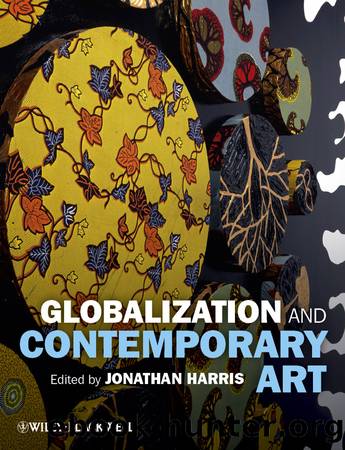Globalization and Contemporary Art by Jonathan Harris

Author:Jonathan Harris
Language: eng
Format: epub
Publisher: Wiley
Published: 2011-03-21T16:00:00+00:00
Rather than conclude, however, with the relatively abstract and cosmological image of the vortex as the turbulent passage between world pictures, I want to leave you with a few thoughts on the intermediate concept of the region, the “excluded middle” that tends to be left out in the polarizing concepts of the global and local. I think that it is no accident that Hardt and Negri discount the importance of “geographical regions” and Marx’s figure of the “Old Mole” of proletarian revolution that burrows through the earth in favor of a highly virtualized Empire whose center is everywhere and circumference is nowhere. For them, all the different struggles against Empire are “incommunicable” with one another. An abstract “multitude” resists an equally abstract “Empire” whose “virtual center … can be attacked from any point” (p. 59).
If we learn any lesson from contemporary politics (say, in the Middle East, but also in the Americas and in Africa and Asia, for instance), it is that the region is a more potent factor than ever before. The military nightmare of our moment turns out to be, not the ICBMs of the Cold War, which were genuinely global in their reach, but the short and intermediate range missile that can go 10 or 20 miles, and be launched from the back of a pickup truck, or the backyard of a cottage. All warfare now is regional warfare, by which I mean that it is almost never fought between nations with armies arrayed against one another but is a complex war of position fought over uncertain and shifting borders, contested terrains, and demilitarized zones with smuggled or improvised weapons.
And this is entirely in keeping with the concept of the region. What is a region? The word comes from regere, “to rule,” a sense that is echoed in related words such as “regime,” “regency,” and “reign” – something very like the “juridical” order postulated for Empire by Hardt and Negri. But the actual use of the term belies this image of a space ruled by law. The “regional imaginary” is likely to be constructed in terms of images of emancipation from political and governmental boundaries, and in general it denotes an area of relatively weak or divided jurisdiction. In American culture, regionalism is the name for forms of cultural resistance to what is seen as the oppressive dominance of the metropolitan regions. Thus, “southern” literature (and “western” and “midwestern”) provide alternatives to the cosmopolitan centers of New York and New England in American literary histories.
Like world pictures, regional imaginaries always display a double, dialectical face. The region is what is “ruled,” but it is also what is free of central rule, contesting the power centers, often in a struggle between the country and the city. Regions are ambiguous with respect to their status as parts or wholes, fragments or totalities: North America is a gigantic (almost) continental region that contains just two nations, the United States. and Canada, and yet each of these countries also contains numerous regions within themselves.
Download
This site does not store any files on its server. We only index and link to content provided by other sites. Please contact the content providers to delete copyright contents if any and email us, we'll remove relevant links or contents immediately.
Periodization Training for Sports by Tudor Bompa(7323)
The MacArthur Bible Commentary by John MacArthur(4227)
The Body: A Guide for Occupants by Bill Bryson(3789)
The Sports Rules Book by Human Kinetics(3581)
What It Really Takes to Get Into Ivy League and Other Highly Selective Colleges by Hughes Chuck(3217)
Marijuana Grower's Handbook by Ed Rosenthal(3114)
The Sprouting Book by Ann Wigmore(3049)
Salt, Fat, Acid, Heat: Mastering the Elements of Good Cooking by Nosrat Samin(2652)
The Martian by Andy Weir(2603)
Classic by Mary Berry(2499)
The Bread Bible by Rose Levy Beranbaum(2467)
Harry Potter 4 - Harry Potter and The Goblet of Fire by J.K.Rowling(2413)
The Marketing Plan Handbook: Develop Big-Picture Marketing Plans for Pennies on the Dollar by Robert W. Bly(2408)
Sapiens and Homo Deus by Yuval Noah Harari(2405)
Martha Stewart's Baking Handbook by Martha Stewart(2328)
50 Economics Classics by Tom Butler-Bowdon(2063)
Screenplay: The Foundations of Screenwriting by Syd Field(2052)
The Cambridge Grammar Of The English Language by Rodney Huddleston Geoffrey K. Pullum(2043)
The Plant Paradox by Dr. Steven R. Gundry M.D(2035)
